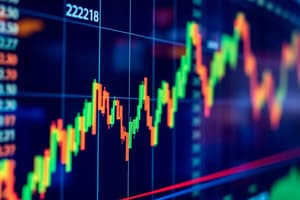Podcast
Questions and Answers
What is the main premise of the capital asset pricing model (CAPM)?
What is the main premise of the capital asset pricing model (CAPM)?
- The model only considers unsystematic risk, which is specific to individual firms.
- Only systematic risk, which is related to overall market movements, is relevant. (correct)
- The model focuses on total risk, including both systematic and unsystematic risk.
- All risks, both systematic and unsystematic, must be considered.
Which factor is NOT explicitly included in the Arbitrage Pricing Model (APM)?
Which factor is NOT explicitly included in the Arbitrage Pricing Model (APM)?
- Inflation
- Economic growth
- Company-specific risk (correct)
- Market risk
What does the beta coefficient (Bj) represent in the CAPM formula?
What does the beta coefficient (Bj) represent in the CAPM formula?
- The standard deviation of the asset's returns
- The expected return of the asset
- The sensitivity of an asset's return to changes in the market return (correct)
- The risk-free rate of return
Which of these is NOT a method for measuring a stock's risk?
Which of these is NOT a method for measuring a stock's risk?
How is a stock's volatility generally measured?
How is a stock's volatility generally measured?
What is the relationship between the beta of a stock and its risk?
What is the relationship between the beta of a stock and its risk?
How is the beta of a stock commonly estimated?
How is the beta of a stock commonly estimated?
Value-at-Risk (VaR) is most closely associated with which type of risk?
Value-at-Risk (VaR) is most closely associated with which type of risk?
What is the primary reason companies issue stocks?
What is the primary reason companies issue stocks?
Which of the following is NOT a category of stocks?
Which of the following is NOT a category of stocks?
What is the primary advantage of investing in common stock?
What is the primary advantage of investing in common stock?
Which of the following is a method of valuing stocks based on discounted cash flows?
Which of the following is a method of valuing stocks based on discounted cash flows?
What is the purpose of the required rate of return?
What is the purpose of the required rate of return?
What is a distinguishing characteristic of blue-chip stocks?
What is a distinguishing characteristic of blue-chip stocks?
Which of the following is NOT a factor that influences the required rate of return on a stock?
Which of the following is NOT a factor that influences the required rate of return on a stock?
Which statement regarding institutional investors' participation in the stock market is TRUE?
Which statement regarding institutional investors' participation in the stock market is TRUE?
Which of these situations would provide the best measure of a stock's performance using the Treynor Index?
Which of these situations would provide the best measure of a stock's performance using the Treynor Index?
If a stock market is said to be semistrong-form efficient, what does it imply?
If a stock market is said to be semistrong-form efficient, what does it imply?
What does a high Sharpe Index indicate about a stock's performance?
What does a high Sharpe Index indicate about a stock's performance?
Which of these is NOT a characteristic of a stock market that is considered to be strong-form efficient?
Which of these is NOT a characteristic of a stock market that is considered to be strong-form efficient?
Which of these would be considered a type of public information relevant to a stock's performance?
Which of these would be considered a type of public information relevant to a stock's performance?
What is one implication of a stock market being weak-form efficient?
What is one implication of a stock market being weak-form efficient?
Which of the following statements best describes the relationship between the Sharpe Index and the Treynor Index?
Which of the following statements best describes the relationship between the Sharpe Index and the Treynor Index?
If you are 95% confident that your worst daily loss on a $100 investment will not exceed $4, how much is the maximum possible loss expressed as a percentage?
If you are 95% confident that your worst daily loss on a $100 investment will not exceed $4, how much is the maximum possible loss expressed as a percentage?
Flashcards
Stocks
Stocks
Securities representing ownership in a company, also called equities.
Market Participants
Market Participants
Actors in the stock market, including individual and institutional investors.
Capital Appreciation
Capital Appreciation
Increase in the stock price, leading to profit for investors.
Dividend Payments
Dividend Payments
Signup and view all the flashcards
Common Stock vs. Preferred Stock
Common Stock vs. Preferred Stock
Signup and view all the flashcards
Types of Stocks
Types of Stocks
Signup and view all the flashcards
Required Rate of Return
Required Rate of Return
Signup and view all the flashcards
Valuation Methods
Valuation Methods
Signup and view all the flashcards
Capital Asset Pricing Model (CAPM)
Capital Asset Pricing Model (CAPM)
Signup and view all the flashcards
Systematic Risk
Systematic Risk
Signup and view all the flashcards
Unsystematic Risk
Unsystematic Risk
Signup and view all the flashcards
Beta
Beta
Signup and view all the flashcards
Arbitrage Pricing Model (APM)
Arbitrage Pricing Model (APM)
Signup and view all the flashcards
Value-at-Risk (VaR)
Value-at-Risk (VaR)
Signup and view all the flashcards
Stock Volatility
Stock Volatility
Signup and view all the flashcards
Risk Measurement
Risk Measurement
Signup and view all the flashcards
Sharpe Index
Sharpe Index
Signup and view all the flashcards
Treynor Index
Treynor Index
Signup and view all the flashcards
Stock Market Efficiency
Stock Market Efficiency
Signup and view all the flashcards
Weak-form Efficiency
Weak-form Efficiency
Signup and view all the flashcards
Semistrong-form Efficiency
Semistrong-form Efficiency
Signup and view all the flashcards
Strong-form Efficiency
Strong-form Efficiency
Signup and view all the flashcards
Abnormal Returns
Abnormal Returns
Signup and view all the flashcards
Study Notes
Stock Markets: Learning Objectives
- Describe the purpose of stock markets.
- Explain methods of valuing stocks and determining the required rate of return.
What are Stocks?
- Stocks are securities that represent a share of ownership in a company.
- Stocks are also called equities.
Who are the Market Participants?
- Individuals: Investments by individuals in large corporations often exceed 50% of the total equity. Individual investments are usually small, resulting in ownership being spread among many shareholders.
- Institutions: Financial institutions like commercial banks, stock-owned savings institutions, savings banks, finance companies, stock mutual funds, securities firms, insurance companies, and pension funds participate in stock markets. Their participation takes various forms, including issuing stock, managing trust funds containing stocks, investing in stocks for portfolios, and using proceeds to invest in stocks. Pension funds often invest a significant portion of their contributions in the stock market.
Role & Function of Stock Markets
- Stock markets facilitate the flow of funds from households, mutual funds, and other institutional investors to corporations to support expansion, operations, and investments.
Why People Buy Stocks?
- Capital appreciation: Increased stock prices.
- Dividend payments: Distributions of company earnings to stockholders.
- Voting rights: Ability to vote and influence company decisions.
Why Companies Issue Stocks?
- Funding: Raise capital for various purposes including paying off debt, launching new products, expanding into new markets, and enlarging facilities.
What Kinds of Stocks are There?
- Common stock: Standard stock
- Preferred stock: A separate class of stock
What Categories of Stocks are There?
- Growth stocks: Earnings grow faster than market average.
- Income stocks: Pay consistent dividends.
- Value stocks: Low price-to-earnings ratio (PE ratio).
- Blue-chip stocks: Shares in large, established companies with a proven history of growth.
Stock Valuation
- The present value of a stock is the sum of the present values of all future dividend payments.
Required Rate of Return on Stocks
- Present Value of a stock: A formula calculating the present value of a stock based on future dividend payments.
- Required rate of return estimation methods:
- Capital asset pricing model (CAPM): Assumes the only relevant risk of a firm is the systematic risk of exposure to general stock market movements. Unsystematic risk is irrelevant.
- The formula is Rᵢ = Rf + Bi(Rm - Rf) where: Rᵢ = return of an asset; Rf = prevailing risk-free rate; Rm = market return; Bi = beta of the asset.
- Arbitrage pricing model (APM): A model suggests that a stock's price can be influenced by a set of factors, in addition to the market, such as economic growth and inflation. The formula is E(R) = Bo + ∑ BiFi. Where: E(R) = expected return of the asset; Bo = a constant; Bi = Sensitivity of the asset return to a particular force; Fi...Fm = values of factors 1 to m
- Capital asset pricing model (CAPM): Assumes the only relevant risk of a firm is the systematic risk of exposure to general stock market movements. Unsystematic risk is irrelevant.
Factors That Affect Stock Prices
- International economic conditions
- U.S. fiscal policy
- U.S. monetary policy
- U.S. economic conditions
- Industry conditions
- Firm-specific conditions
- Stock market conditions
- Market risk premium
- Firm's systematic risk (Beta)
- Risk-free Interest Rate
- Firm risk premium
- Expected Cash Flows
Stock's Risk Measurement
- Volatility: Indicates uncertainty about future returns; measured using standard deviation.
- Beta: Estimated by obtaining past returns of the firm and the market; using regression analyses.
- Value-at-risk (VaR): Measures potential loss in value of an asset or portfolio.
Measuring Stock Performance
- Sharpe index: Measures excess return above the risk-free rate per unit of risk. A higher index implies better performance.
- The formula is (R - Rf) / σ.
- Treynor index: Measures excess return above the risk-free rate per unit of beta. A higher index implies better performance.
- The formula is (R - Rf) / β.
Can Investors Earn Abnormal Returns?
Stock Market Efficiency
- Weak-form efficiency: Security prices reflect all past trade-related information, such as historical prices and trading volume.
- Semistrong-form efficiency: Security prices reflect all publicly available information, such as announcements by firms, economic news, and political events.
- Strong-form efficiency: Security prices reflect all information, including private or insider information.
Key Takeaways
- When valuing a stock using the free cash flow model, an accurate estimate of the required rate of return is essential.
- Stock prices are influenced by factors affecting future cash flows and the investors' required return.
- Stock risk is measured by volatility, beta, and value-at-risk.
- Stock market efficiency implies stock prices reflect available information.
Studying That Suits You
Use AI to generate personalized quizzes and flashcards to suit your learning preferences.




